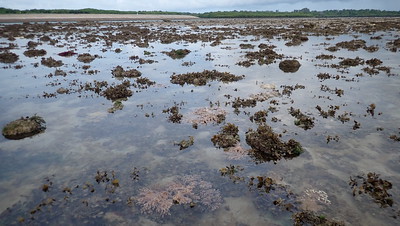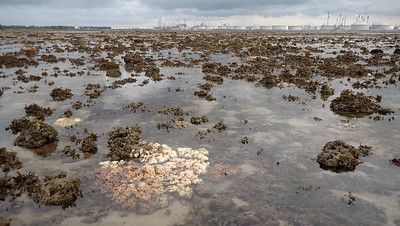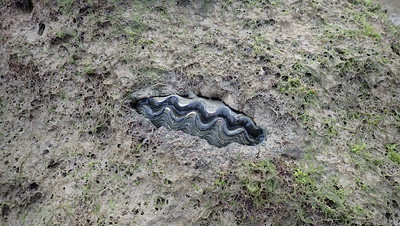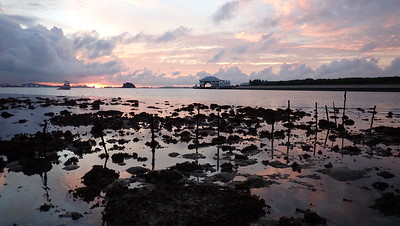Today, I estimate about 5% of the hard corals that I saw are bleaching, with an additional 20% showing stress (paler than usual or with bleaching portions) or with recently dead patches. I didn't see many leathery soft corals. About 5% of these were outright bleaching (white), while about 30% were more yellow than usual. This is not as bad as what I saw during mass coral bleaching here in 2016.
Today, I saw that many of the large coral colonies were not bleaching or only had small pale patches.
But these pale colonies and patches showed up clearly along the reef edge. Most of the corals in the middle of the reef flat were alright.
Across the narrow channel, I could see some corals were still pale on Pulau Semakau (East) which we surveyed about 2 weeks ago.
The situation today is not as bad as what I saw during mass coral bleaching here in 2016. When there were bright white corals on both Terumbu Semakau and Pulau Semakau.
Here's a compilation of some of the hard corals I saw, with a ruler for further study by others.
There are not as many leathery soft corals here as on some other submerged reefs. Those I saw were mostly alright. A nice pink/brown colour that blended well with the surroundings.
Some had pale patches. I only saw a few that was outright bleaching.
I saw some Asparagus flowery soft corals, most were pale. I saw a few bleaching zoanthids. But saw two leathery sea fans that were alright.
There are LOTS of Magnificent anemones on this part of the flat. None of them were bleaching (in fact, I've never seen a bleaching Magnificent anemone). Although some Magnificent anemones had pale body columns, they are like that all the time. There were also many Giant carpet anemones, I only saw one that was rather pale. Most Frilly anemones I saw were alright, only one that was pale.
Marcus saw the Merten's carpet anemone and it was alright.
The Burrowing giant clam is still there! Giant clams can also suffer from bleaching, so it was good to see that this one seemed alright.
We also came across a Banded file snake. Jonathan has created a lovely compilation of photos and videos of this very cute creature.
The seagrass situation seems similar to what I saw in May 2019, i.e., slowly improving. Although heavily covered with epiphytes, there was good cover of Spoon seagrasses on many of the pools in the middle of the reef flat.
There were many clumps of Tape seagrass with longish leaf blades. Although also many clumps with short cropped leaves. I saw many small clusters of Serrated ribbon seagrass that looked fresh and green.
There used to be lush seagrass meadows on Terumbu Semakau. Here's what the seagrass meadows looked like when we visited in June 2010. Let's hope the seagrasses will return soon!
Today, we dealt with this large fish trap that I first saw passing by on our survey of Pulau Semakau 2 weeks ago. The trap was well weighed down by rocks. But there was nothing inside it.
There are also rows of sticks on the shore: possibly used to set up fish nets?
Fate of Terumbu Semakau?
Terumbu Semakau is one of the existing natural shores that may be impacted by the landuse plan by the Ministry of National Development released in Jan 2013 in response to the Populations White Paper with a 6.9 million population target. The dotted margined blue areas are "Possible Future Reclamation".

The other shores impacted by this plan include Pulau Jong, Pulau Hantu, Terumbu Pempang Darat, Terumbu Pempang Tengah, Terumbu Pempang Laut.

The Singapore Blue Plan 2018
Pulau Semakau and nearby islands and submerged reefs have been recommended by the Singapore Blue Plan 2018 for Immediate Conservation Priority.
The Blue Plan recommends the intertidal and subtidal marine areas of Pulau Semakau and adjacent Pulau Hantu, and Pulau Jong to be designated Marine Reserve.
The Blue Plan highlights that Pulau Semakau and its associated patch reefs comprise many ecosystems: coral reefs, mangrove areas, intertidal sandflats, seagrass meadows, and coral reefs. The subtidal area of Pulau Jong is larger than the terrestrial area. Pulau Hantu is a popular dive site has seen increasing interest in the past decade due to biodiversity awareness. If protection is accorded to these three islands, zonation plans for use can be implemented to manage tourism and human impacts.
DOWNLOAD the Plan, SUPPORT the Plan! More on the Singapore Blue Plan 2018 site.
Posts by others on this survey
Marcus Ng
Vincent Choo
Jonathan Tan
Others on this trip: Juria Toramae
Surveys on other shores today
Shawne Goh surveyed Changi
















